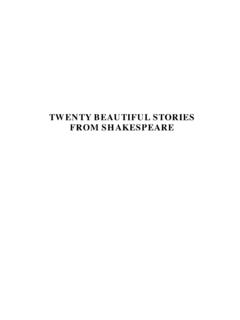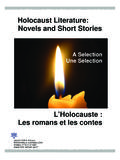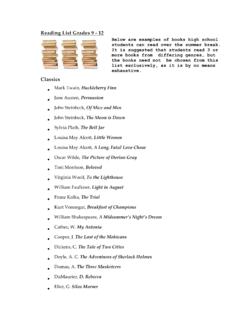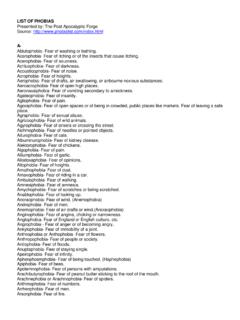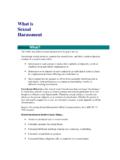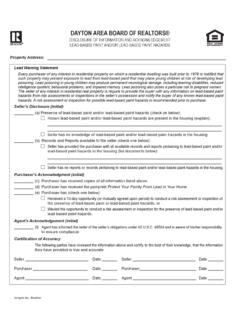Transcription of Reading Reconsidered Reading Spine - Teach Like a …
1 Reading Reconsidered Reading Spine Text Selector for Primary Schools Mr A, Mr C and Mr D Contents The 5 Plagues of a Developing Reader p3 Creation of the List & Application to Long Term Plans p4 Years 1-2 List p5-8 Years 3-4 List p9-11 Years 5-6 List p12-16 Other Books to Consider p17-20 Other Resources p21 The 5 Plagues of the Developing Reader In his book Reading Reconsidered , Doug Lemov points out that there are five types of texts that children should have access to in order to successfully navigate Reading with confidence. These are complex beyond a lexical level and demand more from the reader than other types of books. Read his blog article here: Archaic Language The vocabulary, usage, syntax and context for cultural reference of texts over 50 or 100 years old are vastly different and typically more complex than texts written today.
2 Students need to be exposed to and develop proficiency with antiquated forms of expression to be able to hope to read James Madison, Frederick Douglass and Edmund Spenser when they get to college. Non-Linear Time Sequences In passages written exclusively for students or more specifically for student assessments time tends to unfold with consistency. A story is narrated in a given style with a given cadence and that cadence endures and remains consistent, but in the best books, books where every aspect of the narration is nuanced to create an exact image, time moves in fits and start. It doubles back. The only way to master such books is to have read them time and again and to be carefully introduced to them by a thoughtful teacher or parent.
3 Narratively Complex Books are sometimes narrated by an unreliable narrator- Scout, for example, who doesn t understand and misperceives some of what happened to her. Or the narrator in Edgar Allan Poe s The Tell-Tale Heart who is a madman out of touch with reality. Other books have multiple narrators such as Faulkner s As I Lay Dying. Others have non-human narrators such as the horse that tells the story in Black Beauty. Some books have multiple intertwined and apparently (for a time) unrelated plot lines. These are far harder to read than books with a single plot line and students need to experience these as well. Figurative/Symbolic Text Texts which happen on an allegorical or symbolic level. Not reflected in Lexiles; critical forms of text complexity that students must experience.
4 Resistant Texts Texts written to deliberately resist easy meaning-making by readers. Perhaps half of the poems ever written fall into this category. You have to assemble meaning around nuances, hints, uncertainties and clues. Creation of the List This is an ever-evolving document which will take into account newly released books and other recommendations from the teaching profession. This list has been amended, complied and created by the following people or references: Aiden Severs @That BoyCanTeach Ashley Booth @MrBoothY6 Doug Lemov Gareth Baker Matthew Dix (Mr A, Mr C and Mr D Present) Nottingham ELS Library Service Rob Smith (Literacy Shed) Scott Evans Staff at Forest Fields Primary School The Twitter community of UK teachers To have an input into this project, please email with your recommendations.
5 Please state the book name, the category and the year group it is most suitable for and it will be updated on a termly basis. Application to Long Term Plans The aim of this list is to provide schools with an extensive list of books which they can apply to their own long-term plans. These are books to use as whole class reads, study books or extracts taken from them to look at in greater detail. The idea is that in each year, a child will cover all 5 plagues of Reading so that, by the time they reach year 6 and beyond, they have a good understanding of all of them and are able to access the more complex books expected of them in secondary schools. This only takes into account narratives and poems so a good balance of topic-appropriate non-fiction should also be read to help further develop children s background knowledge of the subject they are studying.
6 Reading Reconsidered Text Selector ARCHAIC Texts Name of Book Author Year Pages The Magic Faraway Tree (4 Book Series) Enid Blyton 1943 224 The Three Billy Goats Gruff Paul Galdone 1973 24 The Tale of Peter Rabbit (23 Book Series) Beatrix Potter 1901 69 The Ugly Duckling Hans Christian Anderson 1844 44 The Little House Virginia Lee Burton 1942 40 The Cat in the Hat Dr. Suess 1957 64 Goodnight Moon Margaret Wise Brown 1947 32 The Little Prince Antoine de Saint-Exupery 1943 96 Aesop s Fables ( The Hare and the Tortoise, The Boy Who Cries Wolf, The Monkey as King etc.) Aesop N/A N/A Traditional stories ( Sleeping Beauty, Rumpelstiltskin, Rapunzel, Puss-in-Boots, The Princess and the Pea, Pinocchio, The Pied Piper of Hamlin, Jack and the Beanstalk) Various Authors N/A N/A The Frog Prince Brothers Grimm 1812 90 Traditional Nursery Rhymes Various Authors N/A N/A The Frog (poem) Hilarie Belloc 1896 N/A A Good Play, The Swing and My Shadow (poems) Robert Louis Stevenson 1888 N/A The Owl and the Pussycat Edward Lear 1871 24 YEARS 1 & 2 Here is our selection of books for Years 1 and 2 carefully selected to cover the 5 Plagues of the Developing Reader.
7 There is a mixture of classics as well as lesser-known books to choose from. Where the Wild Things Are Maurice Sendak 1963 48 The More it Snows (poem) Milne 1928 N/A Who Has Seen the Wind (poem) Christina Rossetti 1872 N/A The Three Little Kittens (poem) Eliza Lee Follen 1860 N/A Make Way for Little Ducklings Robert McCloskey 1941 76 The Night Before Christmas (poem) Clement Clarke Moore 1823 32 Non-Linear Time Sequences Name of Book Author Year Pages Voices in the Park Anthony Brown 1998 32 The Trouble with Trolls Jan Brett 1992 32 Black and White David Macaulay 1990 32 Grandpa John Burningham 2003 32 One Candle Eve Bunting 2002 40 The Stinky Cheese Man and Other Fairly Stupid Tales Jon Scieszka 1993 56 When the Rains Come Tom Pow 2012 48 Three Brave Women Martin 1991 32 The Summer My Father Was Ten Pat Brisson 1998 32 Complexity of the Narrator Name of Book Author Year Pages Chester Melanie Watt 2007 32 Voices in the Park Anthony Brown 1998 32 And the Dish Ran Away with the Spoon Janet Stevens 2001 56 The Very Smart Pea and
8 The Princess to Be Mini Grey 2003 32 Fantastic Mr Fox Roald Dahl 1970 112 Hey Little Ant Hannah and Phillip Hoose 1998 28 The Little House Virginia Lee Burton 1942 40 I Doko, The Tale of a Basket Ed Young 2004 32 Come Away From the Water, Shirley John Burningham 1977 32 The Teddy Bear David McPhail 2002 32 The Day the Crayons Quit Drew Daywalt 2013 40 The Wolf Story: What Really Happened to Little Red Riding Hood Toby Forward 2005 32 The True Story of the Three Little Pigs John Scieszka 1989 32 The Three Little Wolves and the Big Bad Pig Eugene Trivizas 1993 32 Complexity of Plot/Symbol Name of Book Author Year Pages Grandad s Island Benji Davies 2015 32 Wanted: The Perfect Pet Fiona Robertson 2009 32 Owl Babies Martin Waddell 1992 32 The Tiger Who Came to Tea Judith Kerr 1968 32 Slug Needs a Hug Jeanne Willis 2015 32 Where the Wild Things Are Maurice Sendak 1963 48 The Heart and the Bottle Oliver Jeffers 2010 32 Dinosaurs and All That Rubbish Michael Foreman 1993 32 Scissors (poem) Allen Alhberg 1983 N/A I Do Not Mind You Winter Wind (poem)
9 Jack Prelutsky 1984 N/A The Red Tree Shaun Tan 2001 32 The Chickens Build a Wall Jean-Fran ois Dumont 2013 32 Red Kite, Blue Kite Ji-li Jiang 2013 32 The Lotus Seed Sherry Garland 1997 32 The Building Boy Ross Montgomery 2016 32 Resistant Texts Name of Book Author Year Pages The Book With No Pictures Novak 2016 48 Lost and Found Oliver Jeffers 2005 32 Tadpole s Promise Jeanne Willis 2003 32 Wolves Emily Gravett 2005 40 The Colour Monster Anna Llenas 2012 48 Not Now Bernard David McKee 1980 32 Ning Nang Nong (poem) Spike Milligan 1959 N/A The Red Tree Shaun Tan 2001 32 Mirror Jeanne Baker 2010 48 Reading Reconsidered Text Selector ARCHAIC Texts Name of Book Author Year Pages Charlotte s Web White 1952 272 The Children of Green Knowe Lucy M.
10 Boston 1954 128 The Railway Children Edith Nesbit 1905 230 Five Children and It Edith Nesbit 1902 272 Alice s Adventures in Wonderland Lewis Carroll 1865 108 Mary Poppins Travers 1934 192 Just William Richmal Crompton 1922 272 Emil and the Detectives Erich Kastner 1929 224 The Little House on the Prairie Laura Ingalls Wilder 1935 352 Peter Pan Barrie 1911 208 Pippi Longstocking Astrid Lindgren 1945 144 Heidi Johanna Spyri 1880 240 Winnie-the-Pooh Milne 1926 160 The House at Pooh Corner Milne 1928 192 The Little Match Girl Hans Christian Anderson 1845 54 Beauty and the Beast Abridged version 1740 48 The Emperor s New Clothes Hans Christian Anderson 1837 26 The Fishermen and his Wife Brothers Grimm 1812 32 How the Camel got his Hump Rudyard Kipling 1902 24 YEARS 3 & 4 Here is our selection of books for Years 3 and 4 carefully selected to cover the 5 Plagues of the Developing Reader.






